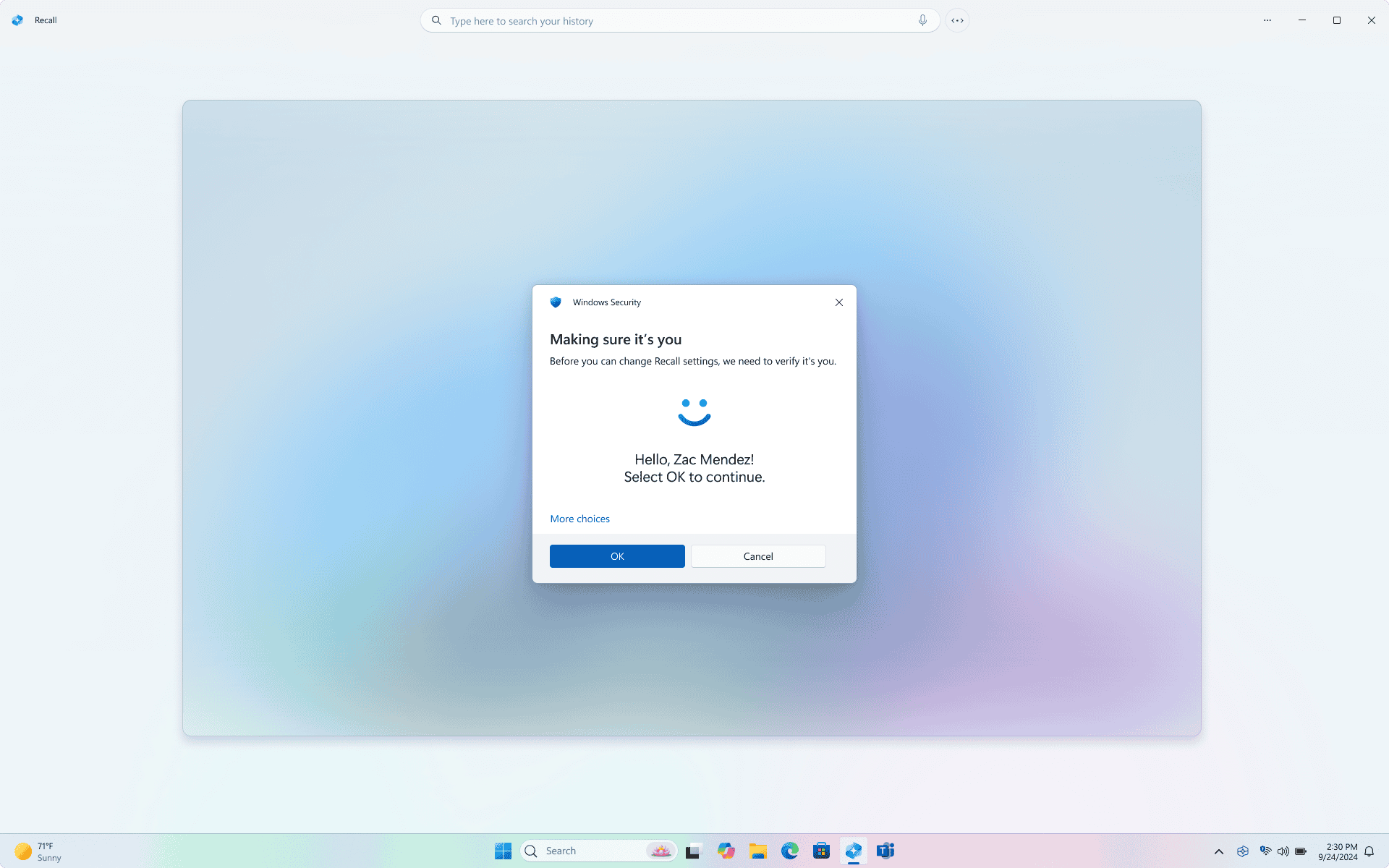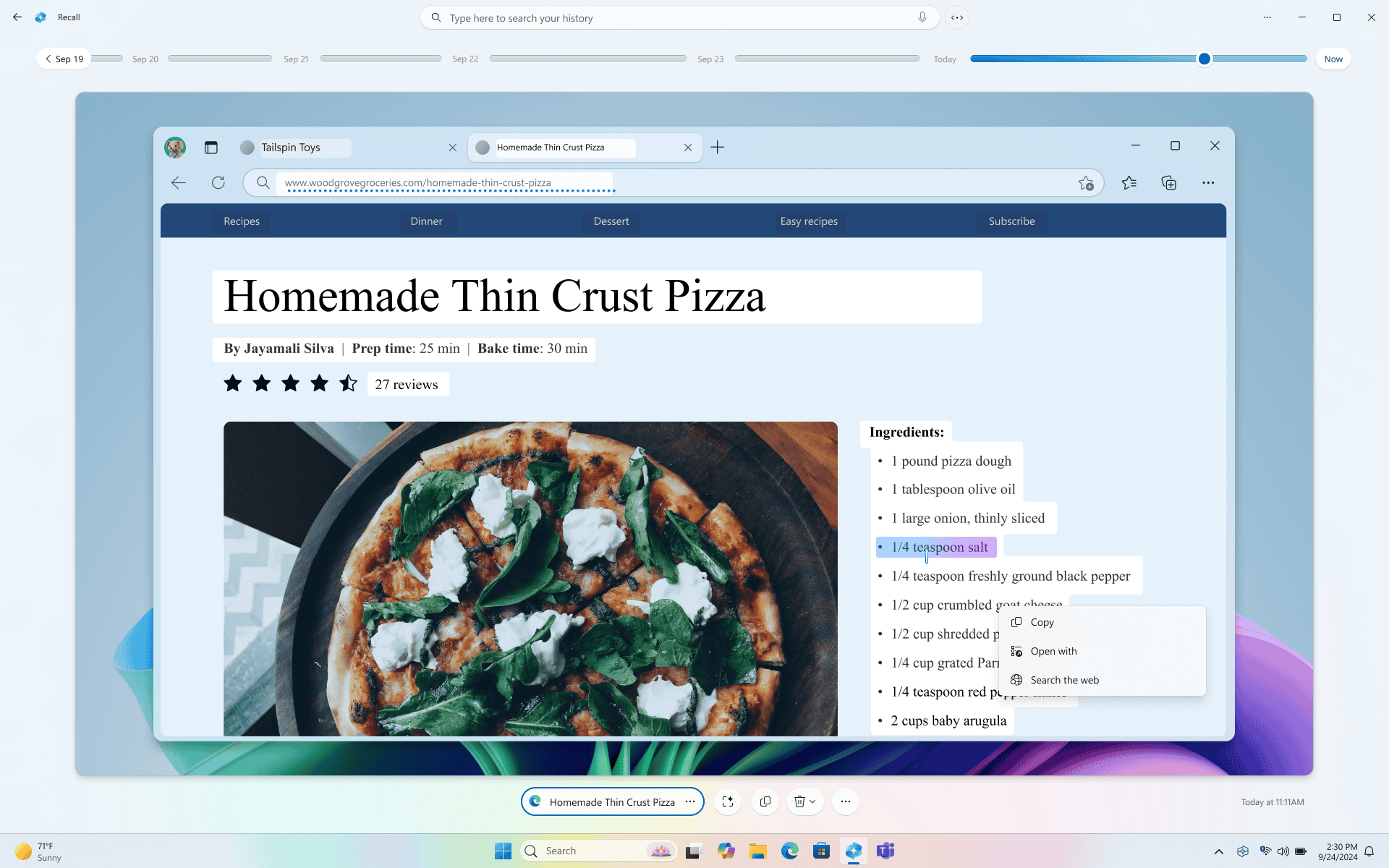Microsoft has redesigned its Recall feature for Windows in response to public concerns about privacy and security. The new system includes better encryption and gives users more control, ensuring a safer experience for those who choose to use it. While Recall shows the potential of AI technology, it also needs to address the privacy issues that come with it. Users should think carefully about their comfort with digital memory, which can provide information but also act as a watchful eye on their digital lives.
In today’s world, privacy is a major concern for technology users and the old version of Windows Recall was causing huge concerns. Features that collect or record data will always face scrutiny (as they should), especially those tracking user activity on personal devices. Companies must consider the effects of such features and make user privacy a priority from the start.

Windows Recall: Addressing Privacy Concerns with Redesign
Initial Concerns and Public Reaction
Microsoft recently announced a new feature called “Recall” for Windows. This feature takes snapshots of your PC screen every few seconds. It aims to help users find past content and activities. However, this feature quickly sparked privacy concerns among users and security experts. People worried about the potential for misuse of this recorded data.
Microsoft’s Response and Redesign

Microsoft has responded to these concerns by announcing a significant redesign of the Recall feature. The company has emphasized its commitment to user privacy. It has implemented several key changes to address the initial worries:
- Local Storage: Recall snapshots will now be stored exclusively on the user’s PC. This change eliminates concerns about data being sent to Microsoft’s servers.
- Enhanced Privacy Controls: Users will have more granular control over what is captured and stored. They can easily exclude specific apps or websites from being recorded.
- Data Encryption: Snapshots will be encrypted on the user’s device. This adds another layer of security to protect sensitive information.
- Simplified Deletion: Microsoft has made it easier for users to delete snapshots. They can delete individual snapshots, time ranges, or all recorded data.
Key Changes in the Redesigned Recall Feature
| Feature | Original Implementation | Redesigned Implementation |
|---|---|---|
| Data Storage | Potential for cloud storage (initially unclear) | Exclusively local storage on the user’s PC |
| Privacy Controls | Limited | Granular controls for excluding apps and websites |
| Data Security | Standard storage | Data encryption on the device |
| Data Deletion | Less clear | Simplified deletion of snapshots |

Looking Ahead
Microsoft’s response to public feedback demonstrates the importance of user privacy. The redesigned Recall feature attempts to balance functionality with robust privacy protections. It remains to be seen how users will adopt the feature. It will be important to see how it performs in real-world usage. The changes show that Microsoft is listening to feedback.
Short Summary:
- The Recall feature, designed to capture and search users’ screen activity, underwent substantial security enhancements.
- Privacy advocates raised alarms over unencrypted data storage, leading Microsoft to make Recall an opt-in feature.
- Recall will only be available to Windows Insiders on specially designed Copilot+ PCs starting in December 2024.
Three months after pulling the rollout of its initially controversial Windows Recall feature, Microsoft is reintroducing the technology with a completely revamped security framework. This transformation comes as a response to mounting privacy and security concerns raised by both consumers and security experts alike. Recall operates as a sophisticated tool that captures snapshots of a user’s screen every few seconds, enabling users to search and retrieve previously accessed content through an AI-powered system. The new version is set to be disabled by default, with users needing to opt-in during system setup.
In an interview with SecurityWeek, Microsoft Vice President of Security, David Weston, described the security advancements as crucial steps towards minimizing the attack surface of the Recall feature. “We’ve never built anything on the client side this significant,” he stated, emphasizing the complete overhaul of the security architecture. The latest design employs proof-of-presence encryption, anti-tampering measures, and Data Loss Prevention (DLP) checks—essentially creating a fortified environment for sensitive data.
“It’s now fully encrypted and tied to the user’s physical presence,” said Weston, highlighting the emphasis on user security.
With the former version of Recall automatically activated, users expressed unease with the constant capturing of their screen activity, including potentially sensitive information. Now, if users do not actively enable Recall, the feature will remain off by default, thus alleviating concerns that the AI system was inherently intrusive. Users will also have the option to completely uninstall Recall, ensuring it is not a feature that runs silently in the background.
Weston elaborated on the renewed approach, explaining that snapshots and all related information will now be encrypted and managed securely within Virtualization-Based Security (VBS) enclaves—restricting any data from leaving the enclave unless explicit user consent is provided. As part of this enhanced security model, user interaction will require verification through Windows Hello, a biometric authentication system, ensuring that no unauthorized access occurs.
Windows Recall is structured for optimal privacy control, allowing users to filter out specific applications or weblinks from recording. Notably, the feature will refrain from capturing data during private browsing sessions and will utilize Microsoft Purview’s data loss prevention technology to block sensitive entities like passwords and ID numbers from being stored in Recall.
In recent months, privacy experts scrutinized the security protocols of Recall, leading to Microsoft’s decision to postpone its initial launch. The feature was first set for introduction in June 2024; however, after concerns about unencrypted data and potential malware attacks exploiteding the system, the company rescheduled the rollout multiple times. Ethical hacker Alexander Hagenah notably showcased vulnerabilities by developing a command-line tool known as TotalRecall that could expose the system’s stored sensitive information.
The December 2024 launch is aimed exclusively for Windows Insiders, providing a controlled environment for Microsoft to gather feedback and further enhance Recall’s functionality. These new Copilot+ PCs are built with advanced hardware, including neural processing units (NPUs), specifically engineered to support AI capabilities efficiently.
Technical Requirements for Recall
To utilize the Recall feature, users will need a compatible Copilot+ PC with the following specifications:
- 16 GB of either DDR5 or LPDDR5 RAM
- At least eight logical processors
- 256 GB total storage with 50 GB free for Recall storage
- Support for BitLocker or Device Encryption
- Essentially, only processes in English and a few other languages will initially be compatible.
Despite the revamped security measures, significant discussions remain regarding the implications of implementing a feature designed to surveil user activity on such a detailed level. While the function of Recall could enhance workflow efficiencies—allowing for faster retrieval of previously viewed content—this surveillance-style memory also raises red flags concerning individual privacy in both personal and professional contexts.
“The mere fact that screenshots will be taken during use of the device could have a chilling effect on people,” cautioned Dr. Kris Shrishak, an AI and privacy adviser.
Microsoft’s efforts to ensure Recall does not infringe on user privacy include configuring the system to uphold important digital rights regulations, targeted to address potential complaints from privacy advocacy groups. In anticipation of scrutiny, the company is committed to acting transparently, especially in regions governed by strict data protection laws like the EU’s GDPR.
Furthermore, the functionality of Recall appears to play a dual role; it offers convenience while also increasing the amount of information users must manage. The concern of surveillance may shift user behavior, distrusting the tool even if assured of its security measures.
Critiques and Further Recommendations
As Microsoft prepares to launch Recall, industry experts and privacy advocates remain skeptical about its implementation. Concerns now extend to the capability of the tool to conduct its primary functions without violating personal privacy. Recommendations for improvement include:
- Enhanced content awareness: Implementing measures that blur sensitive content recorded in the snapshots would help alleviate privacy fears.
- Improved encryption protocols: End-to-end encryption for all data would constitute a greater barrier against potential cyber threats, safeguarding user information throughout its lifecycle.
- Application-specific data management: Adapting Recall to delete snapshots automatically when applications are uninstalled could bolster user confidence, ensuring no residual data remains.
The overall acceptance of Recall will hinge not only on its groundbreaking technology but also on users’ perceptions of its privacy safeguards. The lasting success of Microsoft’s AI initiative lies in the balance between consumer convenience and robust data protection—not only on their machines but also in the skies of public opinion.







